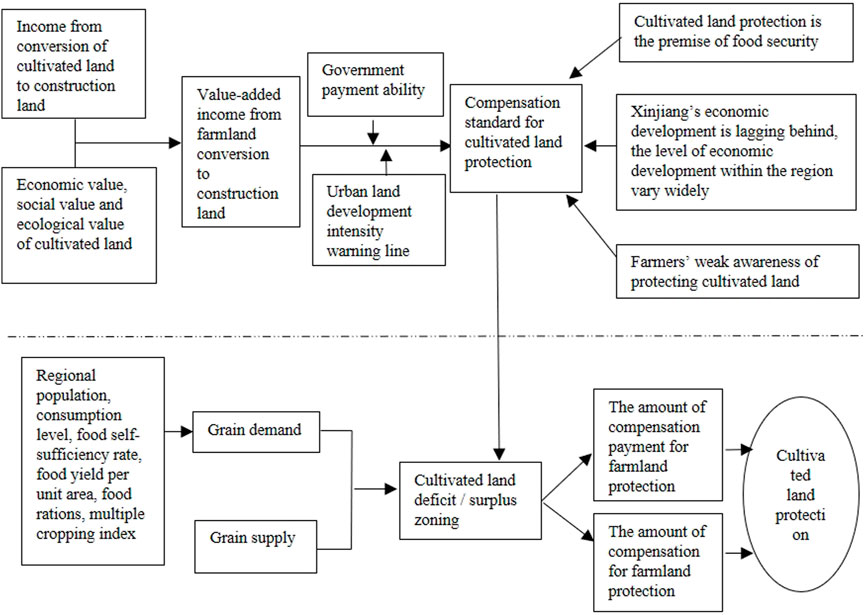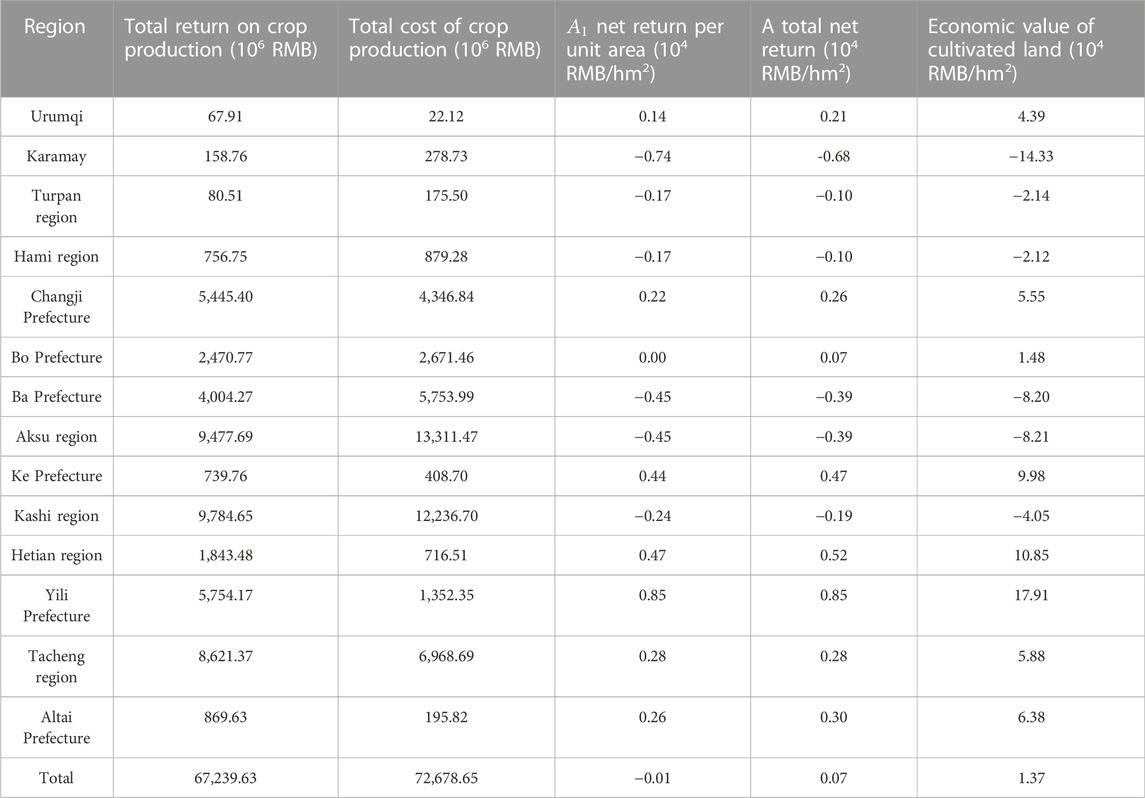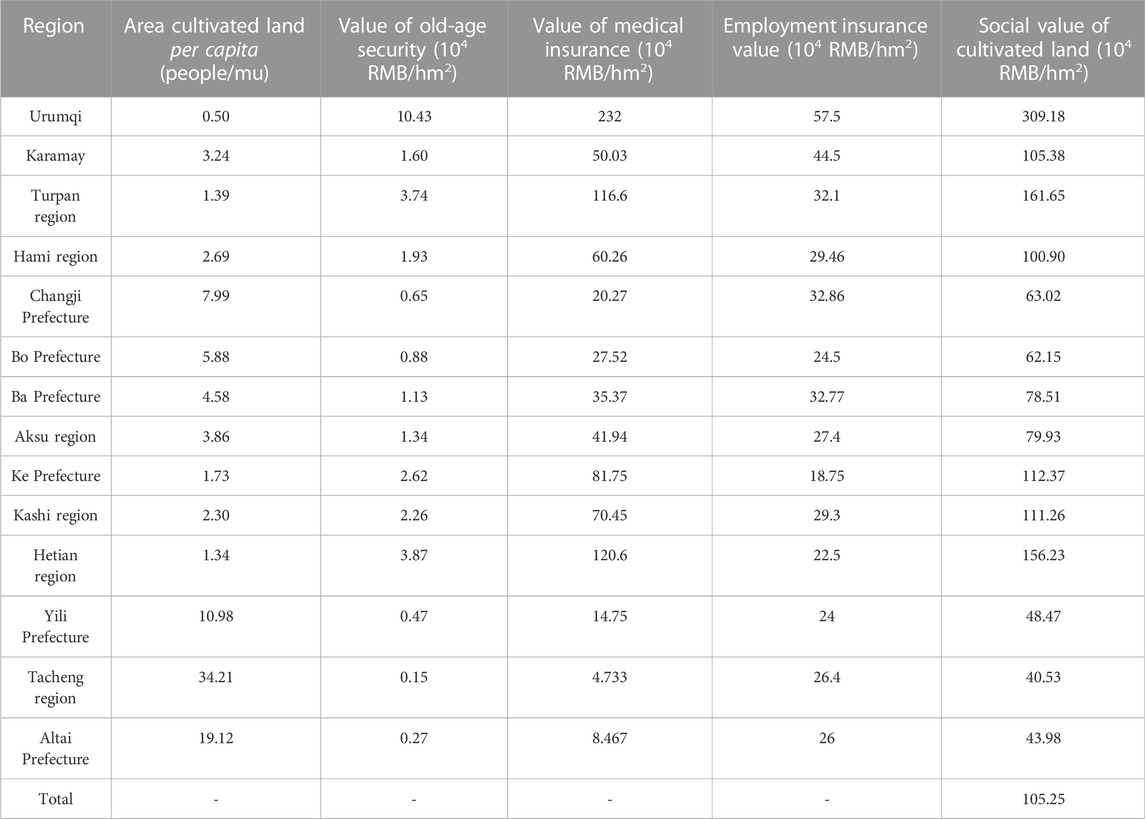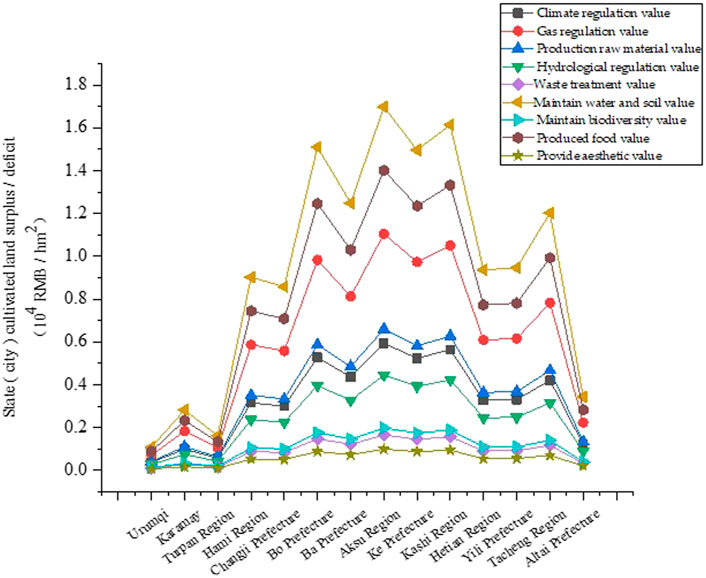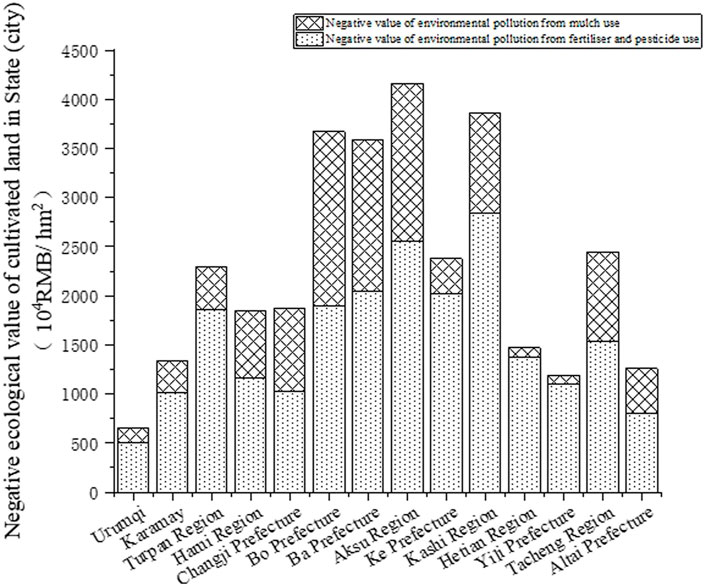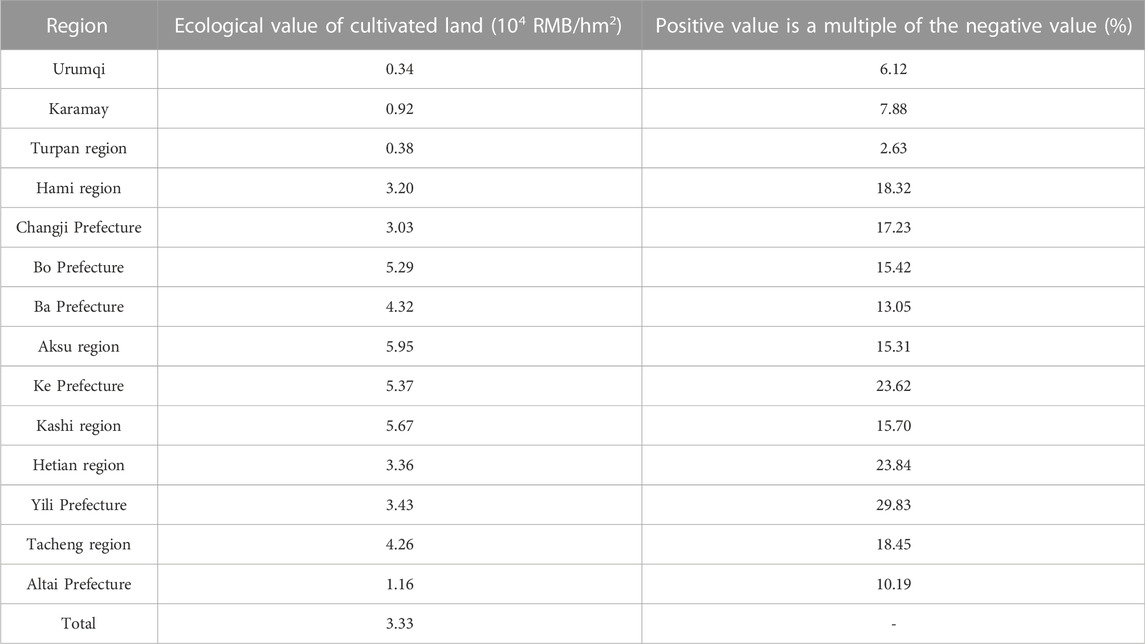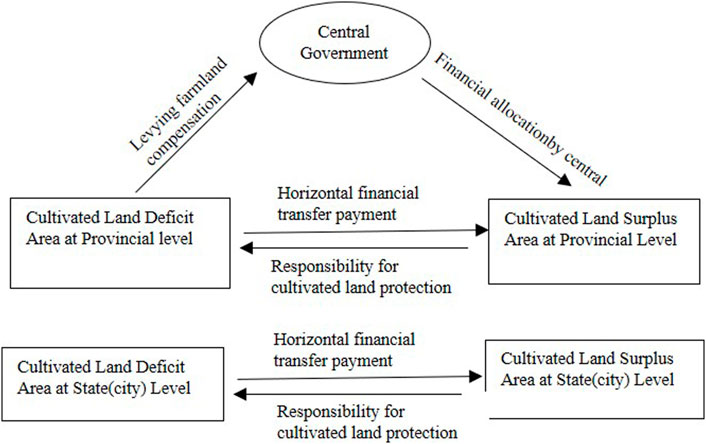- 1College of Science, Shihezi University, Shihezi, China
- 2Key Laboratory of Oasis Town and Mountain Basin System Ecology of Xinjiang Production and Construction Corps, Shihezi, China
- 3School of Mathematical Sciences, Dalian University of Technology, Dalian, China
- 4School of Water Conservancy and Construction Engineering, Shihezi University, Shihezi, China
- 5Modern Water-saving Irrigation Corps Key Laboratory, Shihezi, China
- 6Xinjiang Institute of Ecology and Geography, Chinese Academy of Sciences, Urumchi, China
This study examines the content of the compensation standard measurement for cultivated land protection to effectively address the imbalance between local economic development and cultivated land protection. The empirical analysis relies on a value-added benefit model. Using the grain supply and demand balance method, 14 prefectures (cities) in Xinjiang were divided into cultivated land deficit/surplus areas, and based on the theory of value-added benefits of converting cultivated land to construction land, a compensation standard measurement system for cultivated land protection was established, and correction coefficients such as potential urban development intensity and government payment capacity were introduced to accurately determine the realistic compensation standard for cultivated land protection in areas that are paid and receive compensation. The results of the study found that the total surplus area of cultivated land in Xinjiang is 271.57 × 104 hm2, which is in surplus overall, while within Xinjiang, four states (cities) are cultivated land deficit areas, which are also the areas that need to pay compensation amounts, and 10 states (cities) are cultivated land surplus areas, which receive compensation payments. The average compensation standard for cultivated land protection in Xinjiang is 24.27 × 104 RMB/hm2, while the compensation standard for cultivated land protection in each state (city) is mainly influenced by the benchmark land price and the comprehensive value of cultivated land, of which the benchmark land price is the core factor affecting the compensation standard. In terms of the total amount of compensation, the total amount of compensation paid for cultivated land protection in Xinjiang is 5,323.93 × 108 RMB, which is paid by the provinces where cultivated land is scarce, and in terms of the provinces, by the four compensation areas to the remaining 10 reimbursement areas, for which we put forward policy suggestions such as adopting diversified forms of compensation, alleviating financial pressure, financing through multiple channels, securing sources of funding, establishing cultivated land protection compensation standards, dynamic measurement platforms, and supervision and management mechanisms to realize long-term compensation mechanisms for cultivated land. The study is conducive to clarifying the rights and responsibilities of cultivated land protection, mobilizing the motivation of the main actors in cultivated land protection, and promoting balance and harmony between regional economic development and cultivated land protection.
1 Introduction
Cultivated land is an important strategic resource to ensure food security and maintain social stability. To limit the conversion of large amounts of agricultural land, especially cultivated land, into construction land, China has implemented a strict land use control system (Dang et al., 2021). However, since the 1990s, the area of cultivated land in China has decreased rapidly. According to statistics, only from 2009 to 2018, the area of cultivated land in China has decreased by 393,700 hm2 (Yuan et al., 2021; Cheng et al., 2022). The enthusiasm of cultivated land protection of high cultivated land stakeholders has become an urgent requirement to promote cultivated land protection (Kong et al., 2005; Lu et al., 2022). As the most direct, basic, and main participant, farmers play a particularly important role in land use and cultivated land protection (Liu et al., 2017; Wu et al., 2017). Although China’s current cultivated land protection system has formulated normative implementation measures from the legal and institutional aspects, there are many difficulties in the implementation, and there is a lack of an incentive mechanism for cultivated land protectors after the conversion of cultivated land to construction land (Liu et al., 2017; Huang and Ke, 2020). Its actual value is much higher than the amount of land requisition compensation at that time, which greatly weakens the farmers’ awareness of protecting cultivated land (Wu et al., 2017). Scientifically determining the compensation standard of cultivated land is an important way to enhance farmers’ awareness of protecting cultivated land and to improve the efficiency of cultivated land protection (Zhong et al., 2012; Zhang and Han, 2018; Zhou et al., 2021).
The academic research on the compensation standard of cultivated land protection is roughly divided into three categories: external benefits based on cultivated land protection, opportunities and input costs based on cultivated land protectors, and value-added benefits based on cultivated land conversion to construction land (Yong and Zhang, 2012). The external benefits of cultivated land conservation refer to the corresponding economic compensation to farmers who cannot enjoy the social and ecological exogenous functions generated by cultivated land in the process of production and use (Jin and Du, 2013), and its value is usually measured using the conditional value assessment method (CVM) (Chaudhry et al., 2007; Dorfman et al., 2009; Jin et al., 2018; Lu et al., 2021), the characteristic value analysis method, and the choice test model method (Rolfe et al., 2002; Campbell, 2007; Johnston and Duke, 2007). As the measurement methods are assessed through subjective human perceptions, their results also differ significantly from the actual compensation capacity (Dahal et al., 2018). Opportunities and input costs of cultivated land protectors refer to the sum of the direct input costs of cultivated land protectors to protect cultivated land and the opportunity costs generated by giving up the best use to compensate, which is in line with the behavior of market subjects and objectives (Xia et al., 2020). However, the cultivated land protection compensation scheme constructed with this idea is mainly a direct subsidy from the government to the farmers, which may have problems, such as limited subsidy, scattered subsidy funds, and an inconspicuous effect of cultivated land protection (Zhou et al., 2019). Based on the value-added benefit of converting cultivated land into construction land, which refers to the difference between the value generated by converting cultivated land into construction land and the income from the use of cultivated land for agricultural production (Wang et al., 2021), the compensation value standard of cultivated land measured by this method can solve the problem of uneven income and compensation brought about by land acquisition (Zhang et al., 2018), better highlight the asset attributes of cultivated land, realize the market value of cultivated land, and also conform to the behavior of market economic agents. It provides objectivity and practical operability.
At present, there is no unified standard for measuring the value-added benefits of converting farmland to construction land. Scholars have measured the value-added benefits of converting farmland to construction land from the perspectives of future value-added returns of farmland (Zhang et al., 2008), the value of similar property rights with the same value components in the modified market (Wen et al., 2021), factors affecting value-added benefits (Liu et al., 2020), and willingness to pay (Yang et al., 2019; Peng et al., 2021; Hu et al., 2022). These measurement methods are either complex or difficult to operate. In addition, the research area needs to be expanded. At present, most scholars are concentrated in central and eastern China, while there is little research on the compensation standard of cultivated land in northwest China, especially in Xinjiang. Xinjiang is not only an important ecological security barrier area in China but also a strategic hub area for national development. Its economic and social development is lagging behind, and the contradiction between cultivated land protection and economic development is prominent. In order to solve the problem of unbalanced development and cultivated land protection, it is particularly important to determine the compensation standard of cultivated land protection in Xinjiang.
Based on this, this paper takes 14 states (cities) in Xinjiang as the research objects to supplement the research on compensation standards for cultivated land protection in the northwest region and, on the basis of accounting for the surplus and deficit cultivated land in each state (city), delineates the compensated and reimbursed areas of cultivated land compensation and uses the theory of value-added benefits of converting cultivated land to construction land as the basis. Based on the theory of value-added benefits of converting cultivated land to construction land, the study attempts to construct a value-added benefits measurement model and introduce compensation correction factors to assess the actual value-added benefits of converting cultivated land to construction land in the 14 states (cities) to improve the farmland protection efficiency of farmers, promote the coordinated development of regional economic development and farmland protection, and provide theoretical reference and decision-making reference for the establishment of farmland protection compensation mechanism.
In this study, we aimed to answer the following questions: 1) Is our proposed value-added benefit model applicable to measuring compensation standards for cultivated land protection? 2) What are the compensation standards for cultivated land protection in different regions in Xinjiang? 3) Apart from the payment of compensation, what other ways are there to compensate for the work of cultivated land protection?
2 Materials and methods
2.1 Study area
The Xinjiang Uygur Autonomous Region, referred to as Xinjiang, is located in the northwestern border of China, between 73°40′E–96°18′E and 34°25′N–48°10′N. It is the largest provincial administrative region in China with an area of 1.66 million square kilometers, accounting for one-sixth of the total land area of China. Xinjiang is a typical temperate continental arid climate with rare precipitation and large evaporation, with an average annual precipitation of 170.6 mm. The existing cultivated land area is 7.86343 million mu, the woodland area is 134 million mu, and the grassland area is 748 million mu, which is one of the five major pastoral areas in China. Xinjiang has 14 states (cities), i.e., five autonomous states, five regions, and four prefecture-level cities in Urumqi, Karamay, Turpan, and Hami (see Figure 1); by the end of 2018, Xinjiang’s annual GDP was 1.22 trillion RMB, with 2.487 million permanent residents.
2.2 Data sources
Considering the completeness of the data, this study uses 2018 as the study period. The main data used are as follows: the statistical bulletins on the national economic and social development of 14 states (cities) in Xinjiang in 2018, the 2019 China Statistical Yearbook, the China Urban Statistical Yearbook, the National Compilation of Information on Costs and Benefits of Agricultural Products, the China Agricultural Products Price Adjustment Survey Yearbook, and the Xinjiang Statistical Yearbook. The departmental accounts for the 14 prefectures and cities in Xinjiang, the Natural Resources and Planning Bureau, and the major cities published benchmark land prices and updated assessment results.
2.3 Research methods
The model for measuring the value-added benefits of converting cultivated land to construction land is constructed, in which the compensation and reimbursement areas are defined in terms of food supply and demand. The difference between the net income obtained from converting cultivated land to construction land and the economic, social, and ecological values generated by the agricultural development of cultivated land is taken as the value-added value of converting cultivated land to construction land (Liang et al., 2006; Jiang et al., 2009) (see Figure 2). The compensation and reimbursement areas are combined to finally determine the protection compensation/payment value of cultivated land (Ding and Yao, 2022) so as to lay the foundation for the compensation system for cultivated land protection. This will lay the foundation for the establishment of a farmland protection compensation system. In addition, the value-added benefit of cultivated land converted to construction land in the ideal state is revised by means of a compensation correction factor, making the compensation standard more practical and operable. The studies mentioned above are based on the steady state of cultivated land in Xinjiang; there is no sudden increase/decrease in the number of cultivated lands, and the total crop production does not exist to export and import outside Xinjiang.
2.3.1 Determination of cultivated land surplus and deficit
The regional food supply and demand is used to measure the amount of cultivated land in surplus and deficit and to determine the compensation and reimbursement areas (Li et al., 2014). The amount of cultivated land surplus and deficit in different regions are standardized (Zhou, 2005). The specific formula is as follows:
where Y′ is the cultivated land surplus and deficit; Yg is the amount of cultivated land supply; the cultivated land demand is Yx; Pi is the demand for cultivated land in region i as a function of the population in that region; Di is the grain yield; Fi is the replanting index; Xj is the per capita food demand; hi is the food crop ratio; Z is the food self-sufficiency rate; supply is Yg; Y is the standardized cultivated land surplus and deficit; α is the national grain yield per unit sown area; D is the national grain yield per unit area of the standardized cultivated land; ρ is the national grain yield per unit sown area; and ∂ and F are the grain-sown area share and replanting index, respectively.
2.3.2 Net benefits from the conversion of cultivated land to constructed land
The cultivated land is divided into three categories based on distance from the city: urban cultivated land, suburban cultivated land, and remote cultivated land (Zhang et al., 2018). According to the principle of the location theory (Lin et al., 2017), the closer to the city center, the higher the land price, and the net income from converting these three categories of cultivated land into construction land is measured according to the comprehensive benchmark land price issued by the city, county, and township levels (Zhang et al., 2018). The ratio of the area of cultivated land in the urban area, cultivated land in the suburbs, and remote cultivated land is obtained according to the ratio of cultivated land in areas with similar or the same benchmark land price to the total cultivated land area, which is about 1:2:5 in Xinjiang. The specific formula is as follows:
where VgJ is the value of cultivated land converted to constructed land; Va, Vb, and Vc are the values of cultivated land, suburban cultivated land, and remote cultivated land converted to constructed land in the urban–rural intersection, respectively; and va, vb, and vc are the benchmark land values of cultivated land, suburban cultivated land, and remote cultivated land converted to constructed land in the urban area, respectively.
2.3.3 Net return from the use of cultivated land for agricultural development
1) Economic value of cultivated land resources
The economic value of cultivated land is expressed as income earned in agricultural production, and the best established method of income reduction was chosen to measure (Li et al., 2014; Wang et al., 2020):
In capturing the net benefit of cultivated land A, the net benefit needs to be corrected to below the normal market, usually expressed as a percentage of the government subsidy to agriculture and farmers (Zhou, 2005).
where A1 is the net return from cultivated land used for agricultural production; A2 is the land rent received by farmers in the modified market; pi denotes the total production of crop i; ci denotes the unit price of crop i; di denotes the unit cost of crop i; 40% is the share of land rent received by the owner of the cultivated land, denoting the total land rent of the cultivated land as a proportion of the total agricultural capital; qi is the crop’s sown area; bi is the unit subsidy given by the government to crop i; and S is the total area of cultivated land.
2) The social value of farmland resources
Academicians agree that the social security value and social stability value constitute the social value of cultivated land and that the social security value is reflected in the amount of social security that the cultivated land bears for farming households in lieu of government social security payments (Jin et al., 2018).
1) Value of social old-age security for farmland
Assuming that the farmer loses his land and participates in the insurance with the average capital of an urban resident, the value of social pension insurance per unit area of the cultivated land is (Wang et al., 2008),
where VL is the value of social pension protection for cultivated land; M and W are the bases of single contributions for male and female citizens; m and w are the proportions of male and female citizens in the total population; Gp is the basic pension, including basic pension E and individual account pension F; Go is the monthly premium base; sr is the area of cultivated land per capita; Ls and Lg are the average monthly wages of employed persons and indexed monthly wages of individuals in the previous year, respectively; T is the cumulative length of one’s contributions; v is the cumulative storage capacity of individual accounts; and t is the number of months of accrual.
2) The value of medical insurance on farmland
Farmers’ medical coverage is dependent on farmland, and farmers who lose their land should be entitled to compensation for medical insurance benefits (Yan et al., 2021). The calculation formula is
where Vy is the value of the health insurance on the farmland; B is the annual health insurance contribution paid by the farmer per unit area; and R is the yield reduction rate.
3) Value of employment insurance on farmland
Farmers also need to be compensated for the value of employment security after losing their land. Referring to the unemployment security measures for urban residents, farmers are set to receive a minimum livelihood security payment from the time they lose their land until they retire (Zhu et al., 2011), calculated by the following formula:
4) Social stability value of cultivated land
The social stability value is the value invested by the state to safeguard the productivity of cultivated land, mainly in the form of cultivated land occupation tax a1, cultivated land reclamation fee a2, new vegetable land construction and development fund a3, and new construction land paid use tax a4 charged for occupying cultivated land (Zhu et al., 2011).
3) Ecological value of cultivated land resources
Cultivated land ecosystems not only generate positive values, such as climate regulation, gas regulation, and production of raw materials (Cheng et al., 2019; Li et al., 2019), but also negative values, such as the excessive use of fertilizers and pesticides, and environmental pollution caused by residual mulch (Qi, 2013).
1) Positive value of ecological services of cropland
The dryland unit area equivalent factor refers to the results of the study by Xie et al. (2015), and the ratio of the cropland replanting index in the study area to the national cropland replanting index was selected as the biomass correction factor (Sun et al., 2007), which was calculated by the following formula:
where Vsz is the positive value of the ecological services of cropland; F0 and Fj are the cropland replanting indices of the country and study area j, respectively; C is the crop-sown area; and γ is the unit area equivalent factor.
2) Negative value of ecological services of the cultivated land
a. Negative value of environmental pollution caused by the excessive use of chemical fertilizer and pesticide in the cultivated land.
Due to the widespread use of pesticides and fertilizers by farmers, negative problems, such as eutrophication of water bodies, increased nitrate content in groundwater, and pesticide residues endangering human health, arise. The specific formula for its value is as follows (Liu et al., 2020):
where vhn is the negative value of the cultivated land in the study area due to pesticides and fertilizers;
b. Negative value of mulch residues on cultivated land.
The negative value of residual mulch on cultivated land is calculated as follows, as it damages the soil structure, hinders soil water infiltration, and affects crop growth (Liu et al., 2020).
where vdm is the negative value caused by the residue of mulch on cultivated land;
2.3.4 Value-added benefits of converting cropland to construction land
Theoretically measured value-added benefits of converting cropland to construction land as a compensation standard is too idealistic and unrealistic, and the government’s ability to pay should be considered as an important factor (Zhang and Zhang, 2021), so it needs to be revised. In addition, according to international practice, the maximum threshold for the development intensity of construction land in a city is 30%. Drawing on the ideas of Zhao and Liu (2013) and other urban development intensity measurements, the value should be revised. The formula for calculating the value-added benefit of converting actual cultivated land to construction land is
Vf' is the theoretical value of the value-added benefit of converting cropland to construction land; Vf is the modified value-added benefit of converting cropland to construction land; φ is the current development intensity of the city; Sj and Sz are the total area of construction land and the whole region, respectively; θ is the government’s ability to pay; β1, β2, and β3 are the government’s budget, final budget, and late payment for natural resources, respectively.
2.3.5 Calculation of value-added benefits from the conversion of cropland to constructed land
Whether compensation or payment of value-added benefits from the conversion of cropland to constructed land depends on the amount of cropland deficit in the study area is based on the actual value of development rights as measured by the following equation (Zhang et al., 2018):
where V is the total given value of the right to develop cultivated land in the study area.
3 Results
3.1 Determination of profit and loss of cultivated land
Based on the relationship between grain supply and demand, the surplus and deficit of cultivated land in the 14 states (cities) of Xinjiang were obtained according to Eq. 1 and relevant statistics (see Table 1).
The analysis concluded that the total supply of cultivated land in Xinjiang was greater than the total demand in 2018, which was consistent with the findings of related scholars (Yong and Zhang, 2012), with a total surplus area of 224.36 × 104 hm2. In terms of state (city), the cultivated land in Urumqi, Karamay, Turpan, and Hami were deficit areas. Urumqi has the highest deficit, meaning that it needs to compensate for 17.26 × 104 hm2 of cultivated land, and the second is Turpan, while Karamay and Hami had smaller deficits with 1.69 × 104 hm2 and 1.88 × 104 hm2, respectively. Due to the specificity of the climatic environment, these two areas are rich in melons and fruits, and the area under grain cultivation and the level of grain production are low. The remaining 10 cities and prefectures are in cultivated land surplus areas, which have more cultivated land and surplus cultivated land while meeting the demand, with the largest surplus being in Ili Prefecture directly under the city at 69.00 × 104 hm’, followed by Tacheng Prefecture with a cultivated land surplus of 67.85 × 104 hm2.
3.2 Net benefits of converting cropland to constructed land
As shown in Table 2, the realistic average net return from the conversion of cultivated land to construction land in Xinjiang in 2018 was 284.88 × 104/hm2 RMB, of which the realistic value generated from the conversion of cultivated land to construction land in six regions, namely, Urumqi, Karamay, Aksu, Bayingguoleng Mongol Autonomous Prefecture, and Kashgar and Changji Hui Autonomous prefectures, was greater than the average value across Xinjiang. The better economic development and high benchmark land prices in these cities and prefectures have boosted the value of the cultivated land converted to construction land. The value of the cultivated land converted to construction land in the cities and counties directly under Ili Prefecture is close to the provincial average, and the benchmark land value is relatively high. The other seven regions have average economic development and low benchmark land prices, and the value of the cultivated land converted to construction land in these regions is much less than the average for the whole of Xinjiang.
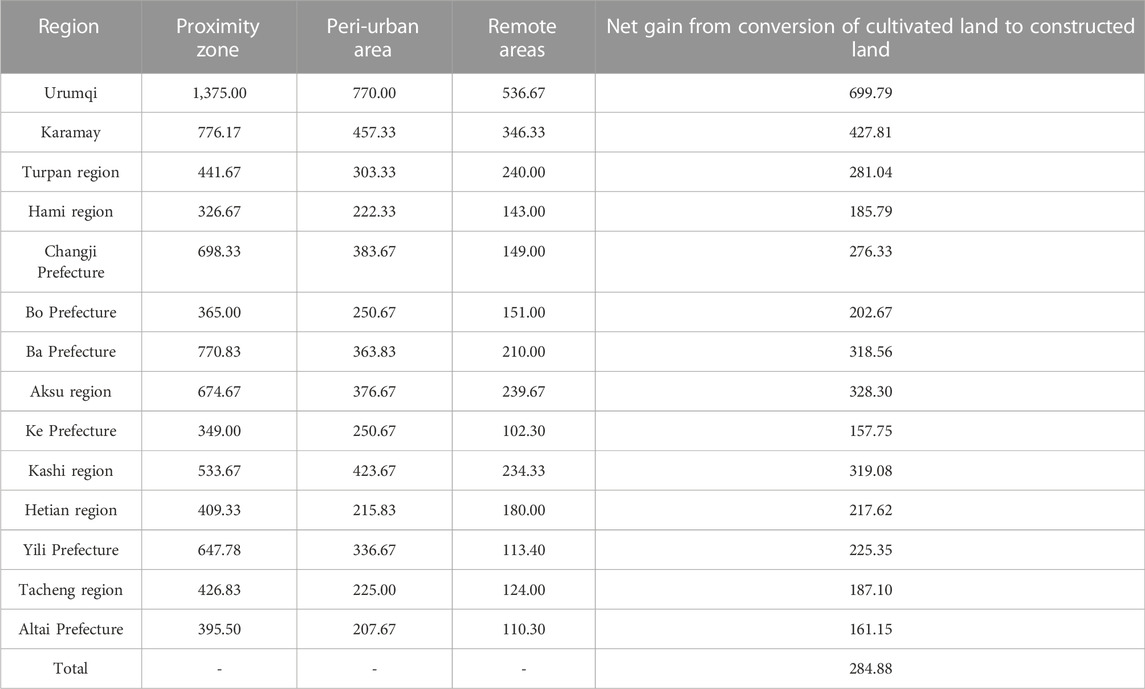
TABLE 2. Value of the cultivated land converted to construction land in the state (city) (104 RMB/hm2).
3.3 Net return of cultivated land for agricultural development
(1)Calculation of the economic value of cultivated land
As shown in Table 3, the overall total return of cultivated land in Xinjiang in 2018 was greater than the total cost of the cultivated land, with the total net return reaching 0.07 × 104 RMB/hm2 and the economic value of the cultivated land being 13,700/hm2 RMB. In terms of crop returns and expenditures, wheat and cotton showed serious losses in net returns per unit area, with losses of 1,668.12 RMB/hm2 and 18,355.2 RMB/hm2, respectively. Only maize showed a better net return situation, and the overall economic benefits of the cultivated land were not significant. From the perspective of the state (city), the economic value of cultivated land in Urumqi, Changji Hui Autonomous Prefecture, Bortala Mongol Autonomous Prefecture, Kizilsu Kirgiz Autonomous Prefecture, Hotan Prefecture, Yili Prefecture, Tacheng Prefecture, and Altay Prefecture is positive. The main crops in these regions are wheat and maize, and the sowing area accounts for about 83.29% of the total sowing area on average. The economic value of the cultivated land in six states (cities) is less than 0. The possible reason is that the crops are mainly cotton, and the sowing proportion is 75.16%, resulting in the low economic value of the cultivated land.
(2) Measurement of the social value of cultivated land
1) Calculation of the value of social old-age security for farmland
When calculating the basic pension, the average age of urban residents is 43 years as the average age of landless farming households. Referring to the China Life Insurance individual pension single payment cost, when citizens are insured at the age of 43, “M” and “W” are taken as 25,069 RMB and 24,965 RMB, respectively. The retirement age is set at 55 years, and the accumulated number of months of personal account pension payment is 170. Through Eqs 10, 11, the value of farmland social pension security is calculated.
2) Calculation of the value of farmland medical insurance
By checking the base of social insurance premium payment for flexibly employed persons released in Xinjiang in 2018, the base of medical insurance payment for flexibly employed persons is 352 RMB/month, and the reduction rate is taken as 4.57%. The value of medical insurance for cultivated land was calculated according to Eq. 12 to find the value of medical insurance for cultivated land.
3) Calculation of the value of farmland employment insurance
According to the minimum living security subsidy standard for urban and rural residents announced by the autonomous region, the minimum-security standard for urban areas in 2018 is 9,000 RMB per year. The retirement age of male and female citizens is 60 and 50 years, respectively, according to national regulations, and the average age in Xinjiang is 43 years. m and n are the approximate ratios of male and female citizens to the total population of 1:1. According to Eq. 13, the value of cultivated land employment insurance is obtained.
4) Calculation of the social stability value of cultivated land
According to “the cultivated land occupation tax law of the People’s Republic of China,” implemented in Xinjiang, combined with the actual situation of the autonomous region, to determine the cultivated land occupation tax within the autonomous region, and according to the “Circular on the Issuance of the Administrative Charge Standard for Land Management in the Autonomous Region System,” the cultivated land reclamation fee shall be charged according to the cultivated land grade; according to the “Xinjiang new construction land paid use standard,” a new construction land paid use tax is levied, according to urban land grade.
Summing up the aforementioned calculations, the social value was derived (see Table 4). From an overall perspective, the average social value of cultivated land in Xinjiang reached 105.25 × 104 RMB/hm2 in 2018, of which the social security value accounted for 72.10% of the total social value, showing that cultivated land has a huge social security capacity for farming households. Looking at the state (city), the seven regions of Urumqi, Turpan, Karamay, Kashgar, Hetian, Hami, and the county-level administrative regions under the autonomous region are all greater than the average across Xinjiang, with the social value of cultivated land in Urumqi being the highest at 309.18 × 104 RMB/hm2, followed by Turpan with a social value of 161.68 × 104 RMB/hm2; both of these places show high average monthly salary of employees, but the per capita cultivated land is very low, at 0.03 person/hm2 and 0.09 person/hm2, respectively, and the cultivated land is under greater pressure to protect and enhance the social security value; the lowest social value of cultivated land is in Altai, at 40.52 × 104 RMB/hm2, with a lower salary of 4,085.25 RMB for employees on the job, but its per capita cultivated land is higher at 2.28 person/hm2.
(3) Calculation of the ecological value of cultivated land
1) Positive ecological value of cultivated land
As shown in Figure 2, the average amount of the positive ecological value of cultivated land in Xinjiang in 2018 was 6.13 × 104 RMB/hm2, of which the value produced by the function of maintaining soil and water and producing food in cultivated land were higher, at 1.64 × 104 RMB/hm2 and 1.35 × 104 RMB/hm2, respectively. Looking at the state (city) (see Figure 3), the positive ecological value of cultivated land in Aksu, Kashgar, Bozhou, Kizilsu, Bazhou, and Tacheng is higher than the provincial average, 6.36 × 104 RMB/hm2, 6.05 × 104 RMB/hm2, 5.66 × 104 RMB/hm2, 5.61 × 104 RMB/hm2, 4.68 × 104 RMB/hm2, and 4.51 × 104 RMB/hm2, respectively. The positive ecological value is mainly related to the biomass in the regional ecosystem. The aforementioned regions have a large area of crops, and the total crop yield is far beyond the provincial average, resulting in a greater ecological value. Ili Prefecture is close to the provincial average and the area of the crop-planting land is also higher, but the planting structure is different and the area is dominated by wheat and corn. The positive ecological value of cultivated land in Urumqi and Turpan is low, mainly due to the small area of crop planting. The former is mainly wheat, and the latter is mainly cotton.
2) Negative ecological value of cultivated land
Pesticide use in the prefecture (city) is difficult to obtain. With the help of the research idea of Huang et al. (2019), the high positive correlation between pesticide use and crop yield is obtained by multiplying the crop share by the total pesticide use in the whole territory. The prices of fertilizers and pesticides were 6.33 RMB/hm2 and 116.70 RMB/hm2, respectively. By substituting the overall obtained data into Eqs 17, 18, the negative value of the excessive use of fertilizers and pesticides on cultivated land and the environmental pollution caused by the residue of mulch on cultivated land in Xinjiang State (city) in 2018 can be derived (see Figure 4). The analysis concluded that the negative ecological value of mulch pollution was high, with the highest negative ecological value in the autonomous county-level administrative regions.
Summing up the calculations, the total ecological value of cultivated land all over Xinjiang State (city) was derived (see Table 5), and as a whole, the average ecological value across Xinjiang in 2018 was at 3.33 × 104 RMB/hm2, which was closely related to the increase in crop yield and value. Among the 14 states (cities), the positive ecological value of the cultivated land was much greater than the negative ecological value, with the highest multiple being 29.83 in Ili Prefecture. The largest ecological value of the cultivated land is of Aksu, with the value being 5.94 × 104 RMB/hm2.
3.4 Calculation of the value-added benefit of converting farmland to construction land
The aforementioned calculation results were combined to obtain the ideal value-added benefit of converting farmland to construction land. Based on the urban development intensity and the government’s ability to pay correction factor, the final value-added benefit of converting cultivated land to construction land in an average state is 34.24 × 104 RMB/hm2 (see Table 6). Among them, Urumqi, Karamay, Bazhou, Aksu, and Kashgar exceed the average level of the whole Xinjiang area, the benchmark land prices in these regions are higher, the government’s ability to pay is also higher, and the value of real cultivated land converted to construction land is also increased; the value-added benefits of cultivated land converted to construction land in the two regions of Tacheng and Yili are close to the average level of Xinjiang, the benchmark land price is above the middle level, the potential development intensity of the city is large, and the compensation standard of cultivated land protection is improved. Changji city’s potential development degree is the smallest, reducing the value; in other regions, the benchmark land price is low, and the social value of the cultivated land is high. Even if the potential development intensity is high, it cannot improve the compensation standard of cultivated land protection.
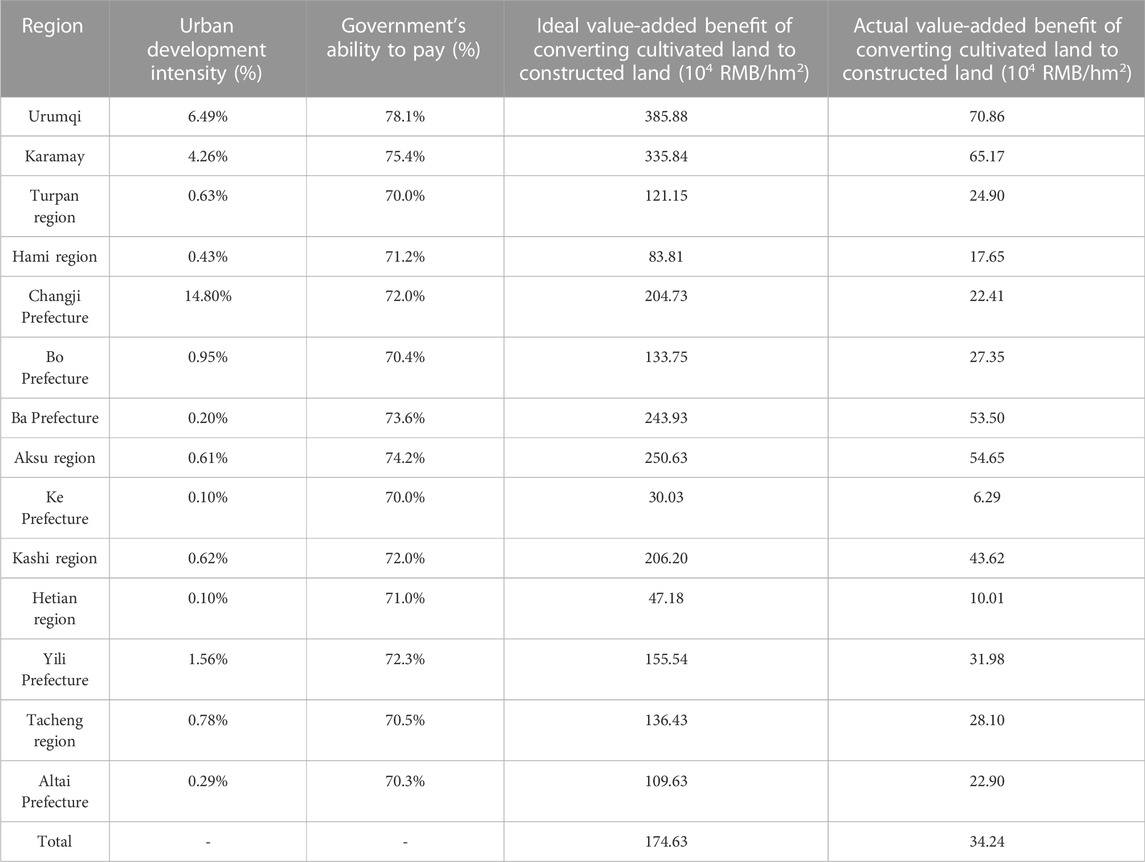
TABLE 6. Correction factors for cultivated land compensation and measurement of actual value-added benefits in the state (city).
3.5 Cultivated land protection compensation payment amount
According to the profit and loss situation of the cultivated land in the 14 states (cities) of Xinjiang, and the actual value of the value-added benefit of cultivated land converted into construction land, the amount of compensation for regional cultivated land protection can be obtained by Eq. 22 (see Figure 5). The analysis shows that the value-added benefits of Urumqi, Karamay, Turpan, and Hami are negative, and they need to pay 1,223.04 × 104 RMB, 110.14 × 104 RMB, 118.28 × 104 RMB, and 33.18 × 104 RMB for cultivated land protection compensation. The most serious loss in Urumqi is mainly due to the rapid development of non-agricultural industries in this area; the demand for cultivated land is more, the deficit of cultivated land is large, and the per capita cultivated land is the lowest in the province, so the payment amount reaches the highest. In the other 10 cities, the value-added benefits of cultivated land converted into construction land are relatively surplus. Among them, Yili Prefecture has the highest compensation amount of 2,206.62 × 104 RMB due to the abundant cultivated land area in Ili Prefecture, the largest amount of grain surplus, and the responsibility of protecting cultivated land.
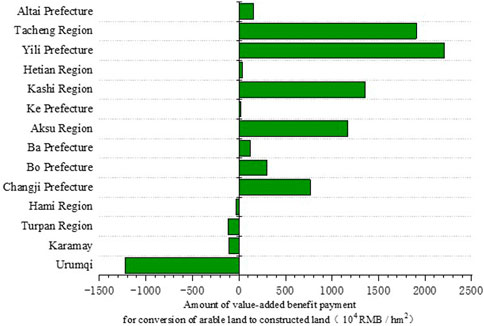
FIGURE 5. Distribution of value-added benefit payments for conversion of cultivated land to constructed land in the state (city).
4 Conclusion
1) Xinjiang’s cultivated land resources were in a surplus state, and the total surplus area was 224.36 × 104 hm2. From the perspective of prefectures and cities, there are four deficit areas, Urumqi, Karamay, Hami, and Turpan. Among them, Urumqi has the most serious loss, which is 17.26 × 104 hm2, and its 10 cultivated land resources are surplus areas.
2) The compensation standard for cultivated land protection in Xinjiang in 2018 was 34.24 × 104 RMB/hm2. The compensation standards of cultivated land protection in each state (city) are mainly affected by the benchmark land price and the three values of cultivated land. Among them, the benchmark land price is the core factor affecting value-added benefits. Among the three values of cultivated land, the calculation results of the economic value of cultivated land in each city are quite different, and the ecological value also has certain differences. The social value of cultivated land with large differences affects the value-added benefits of prefectures and cities to some extent.
3) The overall compensation for cultivated land protection in Xinjiang was large, up to 7,682.57 × 104 RMB. From the level of cities and states, Urumqi, Karamay, Turpan, and Hami are in areas that pay compensation for cultivated land protection, while Tacheng, Yili, Changji, Kashgar, Bozhou, Altay, Bazhou, Hotan, and Kezhou are in areas that receive compensation for cultivated land protection.
5 Discussion
Based on the value-added benefit model of converting cultivated land to construction land, this study combined the profit and loss of cultivated land to measure the standard of compensation for cultivated land protection, which to a certain extent plays a positive role in the protection of cultivated land resources and the coordinated economic and social development between regions. Comparing the calculation results of this paper with existing studies, Wen et al. (2021) measured the value of cultivated land development rights in various provinces across China by constructing an analytical framework for cultivated land protection compensation, which was 42.44 × 104 RMB/hm2 in Xinjiang. Zhang et al. (2018) calculated the value of arable land development rights in Shaanxi Province in 2016 as 50.57 × 104 RMB/hm2. Zhu (2020) measured the value of development rights in Henan Province in 2017 as 25.78 × 104 RMB/hm2. This study and the aforementioned studies both draw on the theory of the development rights value of cropland and then measure the compensation value of cropland protection. Due to the differences in land values and statistical data caused by the differences in research time points and research fields, the results of this study are somewhat different from those of the other studies, but there are similarities in the ideas of constructing the compensation measurement model for cropland, and it is consistent with the actual situation, which indicates the rationality and scientificity of the compensation measurement model constructed in this study. With a more in-depth comparison, this study fully considers the real situation and invokes two correction factors, namely, the government’s ability to pay and the urban development potential, to correct the value of compensation, while other studies only consider the intensity of urban development, but the government’s ability to pay is not explored, and when measuring the value of the cultivated land itself, the measurement of the economic value of cultivated land and the ecological value of cultivated land are added to improve the measurement system. However, the measurement of compensation rates for cultivated land protection is only the basic work of the compensation mechanism for arable land protection, and it is necessary to establish supporting facilities to ensure the realization of a farmland protection compensation mechanism (see Figure 6).
(1) Establishing a compensation method combining various forms
The realization of compensation and payment for cultivated land protection needs strong economic support. However, the overall economic development strength of Xinjiang Province is weak, and the economic development levels of cities and prefectures in the province are also significantly different. It is not suitable to use all the methods of financial subsidies, and hence, a variety of methods, such as capital compensation, material compensation, technical services, and project compensation, should be used.
1) Financial compensation is the most urgently needed compensation. The compensation area compensates part of the fund for the compensation area, that is, the economic compensation fund for cultivated land protection raised from the cultivated land deficit area and social donations, and directly returns it to the local governments and farmers in the cultivated land surplus area in the form of currency according to the corresponding compensation standard, which can effectively realize the fairness of the utilization of the ecological and social benefits of cultivated land; promote the coordinated development between regions; and at the same time, help ensure food security, ecological security, and the stability of the enjoyment of the ecological and social benefits of cultivated land.
2) Physical compensation. The compensation area provides chemical fertilizers, pesticides, seeds, agricultural machinery, and farmland water conservancy facilities in the compensation area, such as the construction of water conservancy and many other types of physical compensation methods, which can effectively avoid the “abuse” of compensation funds. While meeting the needs of some of the life and means of production of the farmers who are the most direct subjects of cultivated land protection, it also reduces the agricultural investment costs of cultivated land users and operators in the key areas of cultivated land protection and improves the economic benefits of farmers, which also plays a certain role in improving the living environment and living standards.
3) Technical services. The compensation area provides technical services to the compensation area, that is, to provide scientific and technological guidance and training to the responsible subjects for implementing farmland protection. This method is conducive to the popularization of advanced farming techniques and cutting-edge farming concepts and is also the key to improving the production capacity of cultivated land. Specific compensation methods include developing pollution-free pesticides, fertilizers, and other production factors, creating new agricultural tools, providing technical compensation advice and guidance to strengthen straw stubble returning technology, residual film recovery, water-saving irrigation technology, and transporting agricultural management and technical personnel to help improve food production and increase farmers’ income in major grain-producing areas.
4) Project compensation. It is suggested to strengthen the project promotion of farmland roads, water-saving irrigation facilities, farmland shelterbelts, and the transformation of medium- and low-yield fields in some compensated areas. It is suggested to adopt open tender procurement and strengthen the supervision of the use of compensation funds for village collective organizations.
(2) Multi-channel financing to increase sources of compensation funds
With the source of compensation at the provincial level, in addition to the subsidy funds allocated by the central government, Xinjiang as a whole is a surplus area of cultivated land throughout the country and bears part of the responsibility for protecting cultivated land in the province with a deficit in the cultivated land. The state can levy a compensation tax on the cultivated land in the province with a deficit in cultivated land, establish a fund management committee to be responsible for the collected tax, and then subsidize the surplus area of cultivated land according to the surplus area of each province.
The compensation funds in the province should be guided by the provincial level and supported by the cities and counties to create a comprehensive and three-dimensional fund pool. In terms of the source of compensation, it is paid by the compensation area according to certain compensation standards and incorporated into the farmland protection institutions. Through the financial transfer payment, it is specially used for the benefit compensation of the compensation area. At the same time, relevant policies can be introduced to encourage and guide social capital investment and ensure the stable source of funds. In addition, the surplus cultivated land index can also be sold to the deficit area where the cultivated land resources are scarce, and the task of the balance of cultivated land occupation and compensation cannot be completed, which is not only conducive to the division of labor and cooperation between regions but also promotes the coordinated development of economic development and cultivated land protection. It also helps curb the phenomenon of over-occupation of cultivated land in areas that cannot complete the occupation of cultivated land and ultimately achieve the purpose of protecting cultivated land (see Figure 7).
(3) Establishing a dynamic accounting platform and supervisory and management institutions for compensation standards for cultivated land protection, and forming a long-term mechanism for compensation for cultivated land protection
In determining the compensation standard for cultivated land, it is necessary to take into account the constant changes in the urban benchmark land price and the three values of cultivated land. A dynamic accounting platform needs to be established to effectively improve the accuracy of the calculation of the value-added benefits of converting cultivated land into construction land so as to ensure the long-term feasibility of the compensation standard for the protection of cultivated land. In addition to the establishment of a protection and supervision and management agency for cultivated land protection compensation, the compensation for cultivated land protection will be paid by the cultivated land deficit areas to the cultivated land compensation protection agency in accordance with the compensation standards and will be paid by the protection agency to the cultivated land surplus areas through financial allocations as compensation for farmers’ benefits. On the basis of good supervision of the funds, the scope and channels for the use of the funds are further broadened, and certain discretion is given to the units responsible for the protection of cultivated land so as to avoid the grassroots being tied up in the use of compensation incentive funds, resulting in a large surplus of funds that do not play their proper role. The “balance point” between fund supervision and fund use can be improved through the management measure of “spending money to ask for results and being accountable for ineffectiveness.”
Data availability statement
The original contributions presented in the study are included in the article/Supplementary Material; further inquiries can be directed to the corresponding author.
Author contributions
YW and XY conducted the analysis and wrote the manuscript. XY provided data and paper corrections. GY provided thesis data and editing. ZF edited the manuscript. BX offered suggestions for revision. LW corrected the manuscript.
Funding
This study was supported by the Special Project for Innovation Development of Shihezi University (Project No. CXFZSK202105 and CXFZ202217), the Science and Technology Research Project in Key Areas of the Corps (Project No. 2021AB021), the Program for Youth Innovation and Cultivation of Talents of Shihezi University (Project No. CXPY202223), and the Program for Young Innovative Talents of Shihezi University (Project No. KX00300302).
Conflict of interest
The authors declare that the research was conducted in the absence of any commercial or financial relationships that could be construed as a potential conflict of interest.
Publisher’s note
All claims expressed in this article are solely those of the authors and do not necessarily represent those of their affiliated organizations, or those of the publisher, the editors, and the reviewers. Any product that may be evaluated in this article, or claim that may be made by its manufacturer, is not guaranteed or endorsed by the publisher.
References
Campbell, D. (2007). Willingness to pay for rural landscape improvements: Combining mixed logit and random-effects models. J. Agric. Econ. 58, 467–483. doi:10.1111/j.1477-9552.2007.00117.x
Chaudhry, P., Singh, B., and Tewari, V. P. (2007). Non-market economic valuation in developing countries: Role of participant observation method in CVM analysis. J. For. Econ. 13, 259–275. doi:10.1016/j.jfe.2006.12.001
Chen, T., Zeng, X., and Hu, Q. (2002). Utilization efficiency of chemical fertilizers among different counties of China. Acta Geogr. Sin., 531–538. doi:10.3321/j.issn:0375-5444.2002.05.004
Cheng, B., Li, H., Yue, S., and Huang, K. (2019). A conceptual decision-making for the ecological base flow of rivers considering the economic value of ecosystem services of rivers in water shortage area of Northwest China. J. Hydrology 578, 124126. doi:10.1016/j.jhydrol.2019.124126
Cheng, H., Wang, X., and Chen, D. (2022). Research on spatial-temporal variations of cultivated land in China based on GlobeLand30. Front. Environ. Sci. 10. doi:10.3389/fenvs.2022.929760
Dahal, R. P., Grala, R. K., Gordon, J. S., Petrolia, D. R., and Munn, I. A. (2018). Estimating the willingness to pay to preserve waterfront open spaces using contingent valuation. Land Use Policy 78, 614–626. doi:10.1016/j.landusepol.2018.07.027
Dang, Y., Wang, Q., and Kong, X. (2021). Research on policy measures to implement the most stringent farming system. China Land Sci., 27–28. doi:10.13816/j.cnki.ISSN1002-9729.2021.10.08
Ding, Z., and Yao, S. (2022). Theory and valuation of cross-regional ecological compensation for cultivated land: A case study of shanxi province, China. Ecol. Indic. 136, 108609. doi:10.1016/j.ecolind.2022.108609
Dorfman, J. H., Barnett, B. J., Bergstrom, J. C., and Lavigno, B. (2009). Searching for farmland preservation markets: Evidence from the Southeastern US. Land Use Policy 26, 121–129. doi:10.1016/j.landusepol.2008.02.011
Hu, P., Zhou, Y., Zhou, J., Wang, G., and Zhu, G. (2022). Uncovering the willingness to pay for ecological red lines protection: Evidence from China. Ecol. Indic. 134, 108458. doi:10.1016/j.ecolind.2021.108458
Huang, H., and Ke, X. (2020). Demarcating of permanent prime farmland for synergy of farmland protection and urban expansion: A case study of wuhan. J. Geo-information Sci. 22, 592–604.
Huang, X., Li, C., and Huang, L. (2019). Study on regional differences of pesticide and fertilizer application in China based on provincial data. Ecol. Econ. 35, 118–124.
Jiang, G., Kong, X., Zhang, F., Li, C., and Zheng, H. (2009). Analyzing the mechanism of economic compensation for farmland protection. China Land Sci. 7, 24–27. doi:10.3969/j.issn.1001-8158.2009.07.005
Jin, J., He, R., Wang, W., and Gong, H. (2018). Valuing cultivated land protection: A contingent valuation and choice experiment study in China. Land Use Policy 74, 214–219. doi:10.1016/j.landusepol.2017.09.023
Jin, X., Du, J., Johnston, R. J., and Duke, J. M. (2007). Research progress on compensation for farmland protection:A structural review 27. Am. J. Agric. Econ. 89, 471098–541115. Willingness to pay for agricultural land preservation and policy process attributes: Does the method matter? doi:10.1111/j.1467-8276.2007.01029.x
Kong, X., Zhang, F., Jiang, G., and An, P. (2005). Inspiration of foreign experience on arable land protection of beijing. China Land Sci. 19, 50–54+14. doi:10.3969/j.issn.1001-8158.2005.05.010
Li, G., Fang, C., Qiu, D., and Wang, L. (2014). Impact of farmer households' livelihood assets on their options of economic compensation patterns for cultivated land protection. J. Geogr. Sci. 24, 331–348. doi:10.1007/s11442-014-1091-5
Li, Y., Tan, M., and Hao, H. (2019). The impact of global cropland changes on terrestrial ecosystem services value, 1992–2015. J. Geogr. Sci. 29, 323–333. doi:10.1007/s11442-019-1600-7
Liang, S., Jiang, N., and Gu, S.-z. (2006). Analysis and modeling on cultivated land conversion - case study of hebei province. Chin. Geogr. Sc. 16, 18–23. doi:10.1007/s11769-006-0018-1
Lin, L., Ye, Z., Gan, M., Shahtahmassebi, A. R., Weston, M., Deng, J., et al. (2017). Quality perspective on the dynamic balance of cultivated land in wenzhou, China. Sustainability 9, 95. doi:10.3390/su9010095
Liu, L., Zhang, B., and Liu, X. (2020). Compensation of provincial cultivated land protection in China from the dual perspectives of food security and ecological security. Trans. Chin. Soc. Agric. Eng. 36, 252–263. doi:10.11975/j.issn.1002-6819.2020.19.029
Liu, X., Zhao, C., and Song, W. (2017). Review of the evolution of cultivated land protection policies in the period following China's reform and liberalization. Land Use Policy 67, 660–669. doi:10.1016/j.landusepol.2017.07.012
Lu, H., Chen, Y., Huan, H., and Duan, N. (2022). Analyzing cultivated land protection behavior from the perspective of land fragmentation and farmland transfer: Evidence from farmers in rural China. Front. Environ. Sci. 10. doi:10.3389/fenvs.2022.901097
Lu, S., Zhong, W., Li, W., and Taghizadeh-Hesary, F. (2021). Regional non-point source pollution control method: A design of ecological compensation standards. Front. Environ. Sci. 9. doi:10.3389/fenvs.2021.724483
Peng, Z., Wu, H., Ding, M., Li, M., Huang, X., Zheng, R., et al. (2021). Ecological compensation standard of a water-receiving area in an inter-basin water diversion based on ecosystem service value and public willingness: A case study of beijing. Sustainability 13, 5236. doi:10.3390/su13095236
Qi, X. (2013). Spatial and temporal change of positive and negative services value and its impact factors in regional farmland ecosystem: A case study in shandong province. Res. Agric. Mod. 34, 622–626.
Rolfe, J., Bennett, J., and Louviere, J. (2002). Stated values and reminders of substitute goods: Testing for framing effects with choice modelling. Aust. J. Agric. Res. Econ. 46, 1–20. doi:10.1111/1467-8489.00164
Sun, X., Zhou, H., and Xie, G. (2007). Ecological services and their values of Chinese agroecosystem. China Popul. Resour. Environ. 17, 55–60. doi:10.3969/j.issn.1002-2104.2007.04.012
Wang, H., Lu, S., Lu, B., and Nie, X. (2021). Overt and covert: The relationship between the transfer of land development rights and carbon emissions. Land Use Policy 108, 105665. doi:10.1016/j.landusepol.2021.105665
Wang, K., Ou, M., and Wolde, Z. (2020). Regional differences in ecological compensation for cultivated land protection: An analysis of chengdu, sichuan province, China. Int. J. Environ. Res. Public Health 17, 8242. doi:10.3390/ijerph17218242
Wang, S., Huang, X., Chen, Z., Tan, D., and Wang, G. (2008). Study on compensation standard of land expropriation based on value of cultivated land. China Land Sci. 22, 44–50. doi:10.3969/j.issn.1001-8158.2008.11.008
Wen, L., Zhang, B., Kong, X., Dang, Y., and Wang, X. (2021). Construction and calculation of cultivated land protection compensation framework based on regional coordination in China. J. China Agric. Univ. 26, 155–171. doi:10.11841/j.issn.1007-4333.2021.07.16
Wu, Y., Shan, L., Guo, Z., and Peng, Y. (2017). Cultivated land protection policies in China facing 2030: Dynamic balance system versus basic farmland zoning. Habitat Int. 69, 126–138. doi:10.1016/j.habitatint.2017.09.002
Xia, X., Zhu, L., Yang, A., Jin, H., and Zhang, Q. (2020). Evaluate the positive and negative value of ecosystem services based on mountain-desert-oasis system (MODS): A case study of manas river basin in Xinjiang. Acta Ecol. Sin. 40, 3921–3934. doi:10.5846/stxb201901280207
Xie, G., Zhang, C., Zhang, L., Chen, W., and Li, S. (2015). Improvement of the evaluation method for ecosystem service value based on per unit area. J. Nat. Resour. 30, 1243–1254. doi:10.11849/zrzyxb.2015.08.001
Yan, X., Wang, Y., Liao, N., Xu, H., and Fan, Z. (2021). Assessment of value changes and spatial differences in land use based on an empirical Survey in the manas river basin. Land 10, 961. doi:10.3390/land10090961
Yang, X., Zhang, A., and Zhang, F. (2019). Farmers' heterogeneous willingness to pay for farmland non-market goods and services on the basis of a mixed logit model-A case study of wuhan, China. Int. J. Environ. Res. Public Health 16, 3876. doi:10.3390/ijerph16203876
Yong, X., and Zhang, A. (2012). Discussion on the compensation standard of the arable land protection based on food security. Resour. Sci. 34, 749–757.
Yuan, C., Zhang, D., Liu, L., and Ye, J. (2021). Regional characteristics and spatial-temporal distribution of cultivated land change in China during 2009-2018. Trans. Chin. Soc. Agric. Eng. 37, 267–278. doi:10.11975/j.issn.1002-6819.2021.01.032
Zhang, H., Jin, Y., Wang, B., Feng, S., and Qu, F. (2018). Compensation for cultivated land protection of Shaanxi province based on calculation of cultivated land development rights. Trans. Chin. Soc. Agric. Eng. 34, 256–266.
Zhang, X., and Han, L. (2018). Which factors factors affect farmers' willingness for rural community remediation? A tale of three rural villages in China. Land Use Policy 74, 195–203. doi:10.1016/j.landusepol.2017.08.014
Zhang, X., Ou, M., Li, J., and Zang, J. (2008). On application of regional compensation mechanism to cultivated land preservation—a case study of heilongjiang province and fujian province. J. Huazhong Agric. Univ. Sci. Ed., 154–160. doi:10.3969/j.issn.1002-2104.2008.05.028
Zhang, Y., and Zhang, A. (2021). Study on the fiscal transfer payment of cultivated land ecological compensation based on the perspe. Chin. J. Agric. Resour. Regional Plan. 42, 220–232. doi:10.7621/cjarrp.1005-9121.20211122
Zhao, Y., Liu, Y., Hu, K., Zhang, J., Zeng, M., Liu, C., et al. (2013). Sevoflurane induces short-term changes in proteins in the cerebral cortices of developing rats. Acta Anaesthesiol. Scand. 35, 380–390. doi:10.1111/aas.12018
Zhong, T., Huang, X., Zhang, X., Scott, S., and Wang, K. (2012). The effects of basic arable land protection planning in Fuyang County, Zhejiang Province, China. Appl. Geogr. 35, 422–438. doi:10.1016/j.apgeog.2012.09.003
Zhou, J. (2005). Study on the theory and techniques of cultivated land valuation. Nanjing, China: Nanjing Agricultural University.
Zhou, Y., Li, X., and Liu, Y. (2021). Cultivated land protection and rational use in China. Land Use Policy 106, 105454. doi:10.1016/j.landusepol.2021.105454
Zhou, Y., Zhou, J., Liu, H., and Xia, M. (2019). Study on eco-compensation standard for adjacent administrative districts based on the maximum entropy production. J. Clean. Prod. 221, 644–655. doi:10.1016/j.jclepro.2019.02.239
Keywords: value-added benefit measurement model, cultivated land protection, compensation standard, value of cultivated land, Xinjiang
Citation: Wang Y, Yan X, Wang L, Xia B, Yang G and Fan Z (2023) Research on compensation standards for cultivated land protection based on a value-added benefit model in Xinjiang, China. Front. Environ. Sci. 10:1055291. doi: 10.3389/fenvs.2022.1055291
Received: 27 September 2022; Accepted: 06 December 2022;
Published: 04 January 2023.
Edited by:
Minghong Tan, Institute of Geographic Sciences and Natural Resources Research (CAS), ChinaCopyright © 2023 Wang, Yan, Wang, Xia, Yang and Fan. This is an open-access article distributed under the terms of the Creative Commons Attribution License (CC BY). The use, distribution or reproduction in other forums is permitted, provided the original author(s) and the copyright owner(s) are credited and that the original publication in this journal is cited, in accordance with accepted academic practice. No use, distribution or reproduction is permitted which does not comply with these terms.
*Correspondence: Xin Yan, MjAyMDIwMTgwMDdAc3R1LnNoenUuZWR1LmNu
 Yuejian Wang1,2
Yuejian Wang1,2 Xin Yan
Xin Yan Guang Yang
Guang Yang
